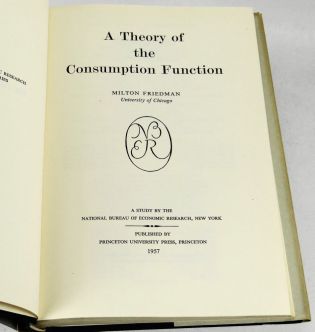Milton Friedman’s permanent income hypothesis — so wrong, so wrong Milton Friedman’s Permanent Income Hypothesis (PIH) says that people’s consumption isn’t affected by short-term fluctuations in incomes since people only spend more money when they think that their life-time incomes change. Believing Friedman is right, mainstream economists have for decades argued that Keynesian fiscal policies therefore are ineffectual. As shown over and over again for the last three decades, empirical facts totally disconfirm Friedman’s hypothesis. The final nail in the coffin is new research from Harvard: Unemployment is a particularly good setting for testing alternative models of consumption because it causes such a large change in family income. A literature
Topics:
Lars Pålsson Syll considers the following as important: Economics
This could be interesting, too:
Lars Pålsson Syll writes Schuldenbremse bye bye
Lars Pålsson Syll writes What’s wrong with economics — a primer
Lars Pålsson Syll writes Krigskeynesianismens återkomst
Lars Pålsson Syll writes Finding Eigenvalues and Eigenvectors (student stuff)
Milton Friedman’s permanent income hypothesis — so wrong, so wrong
 Milton Friedman’s Permanent Income Hypothesis (PIH) says that people’s consumption isn’t affected by short-term fluctuations in incomes since people only spend more money when they think that their life-time incomes change. Believing Friedman is right, mainstream economists have for decades argued that Keynesian fiscal policies therefore are ineffectual.
Milton Friedman’s Permanent Income Hypothesis (PIH) says that people’s consumption isn’t affected by short-term fluctuations in incomes since people only spend more money when they think that their life-time incomes change. Believing Friedman is right, mainstream economists have for decades argued that Keynesian fiscal policies therefore are ineffectual.
As shown over and over again for the last three decades, empirical facts totally disconfirm Friedman’s hypothesis. The final nail in the coffin is new research from Harvard:
Unemployment is a particularly good setting for testing alternative models of consumption because it causes such a large change in family income. A literature starting with Akerlof and Yellen (1985), Mankiw (1985) and Cochrane (1989) has argued that because ignoring small price changes has a second-order impact on utility, a rule of thumb such as setting spending changes equal to income changes may be “near-rational.” More recently, many researchers have documented evidence of an immediate increase in spending in response to tax rebates and similar one-time payments …
We compare the path of spending during unemployment in the data to three benchmark models and find that the buffer stock model fits better than a permanent income model or a hand-to-mouth model …
To summarize, we find that families do relatively little self-insurance when unemployed as spending is quite sensitive to current monthly income. We built a new dataset to study the spending of unemployed families using anonymized bank account records from JPMCI. Using rich category-level expenditure data, we find that work-related expenses explain only a modest portion of the spending drop during unemployment. The overall path of spending for a seven-month unemployment spell is consistent with a buffer stock model where agents hold assets equal to less than one month of income at the onset of unemployment. Because unemployment is such a large shock to income, our finding that spending is highly sensitive to income overcomes the near-rationality critique applied to prior work. Finally, we document a puzzling drop in spending of 11% in the month UI benefits exhaust, suggesting that families do not prepare for benefit exhaustion.
So — now we know that consumer behaviour is influenced by short-term fluctuations in incomes and that this is true even if consumers know that their situation may well change in the future.
Since almost all modern mainstream macroeconomic theories are based on PIH –standardly used in formulating the consumption Euler equations that make up a vital part of ‘modern’ New Classical and New Keynesian macro models — these devastating findings are extremely problematic.
In many modern macroeconomics textbooks, one explicitly adopt a ‘New Keynesian’ framework, adding price rigidities and a financial system to the usual neoclassical macroeconomic set-up. Elaborating on these macromodels one soon arrives at specifying the demand side with the help of the Friedmanian Permanent Income Hypothesis and its Euler equations.
But if people — not the representative agent — at least sometimes can’t help being off their labour supply curve — as in the real world — then what are these hordes of Euler equations that you find ad nauseam in these ‘New Keynesian’ macromodels gonna help us?
My doubts regarding macro economic modelers’ obsession with Euler equations is basically that, as with so many other assumptions in ‘modern’ macroeconomics, Euler equations, and the PIH that they build on, don’t fit reality.
In the standard neoclassical consumption model people are basically portrayed as treating time as a dichotomous phenomenon – today and the future — when contemplating making decisions and acting. How much should one consume today and how much in the future? The Euler equation used implies that the representative agent (consumer) is indifferent between consuming one more unit today or instead consuming it tomorrow. Further, in the Euler equation we only have one interest rate, equated to the money market rate as set by the central bank. The crux is, however, that — given almost any specification of the utility function – the two rates are actually often found to be strongly negatively correlated in the empirical literature!
From a methodological perspective yours truly has to conclude that these kind of microfounded macroeconomic models are a rather unimpressive attempt at legitimizing using fictitious idealizations — such as PIH and Euler equations — for reasons more to do with model tractability than with a genuine interest in understanding and explaining features of real economies. Mainstream economists usually do not want to get hung up on the assumptions that their models build on. But it is still an undeniable fact that theoretical models building on piles of known to be false assumptions — such as PIH and the Euler equations that build on it — in no way even get close to being scientific explanations. On the contrary. They are untestable and hence totally worthless from the point of view of scientific relevance.
Ganong’s and Noel’s research finally shows that mainstream macroeconomics, building on the standard neoclassical consumption model with its Permanent Income Hypothesis and Euler equations, has to be replaced with something else. Preferably with something that is both real and relevant, and not only chosen for reasons of mathematical tractability or for more or less openly market fundamentalist ideological reasons.
